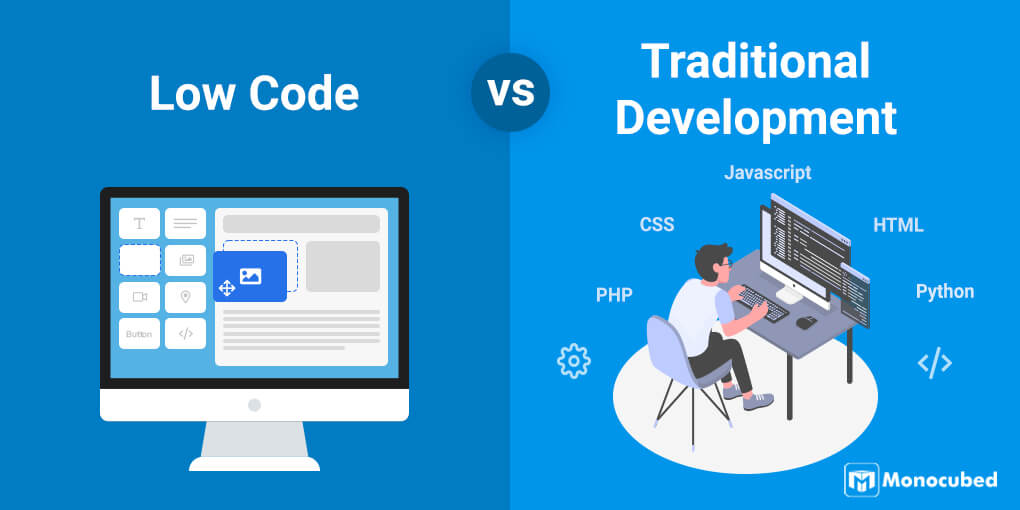Top Reasons For Selecting Legacy application modernization with Low-code
Top Reasons For Selecting Legacy application modernization with Low-code
Blog Article
Speed-WiseLow-Code Applications Have Many Advantages.
Development of low-code applications significantly increases development speed because of several crucial factors. Development Environment:
Drag-and-Drop Interfaces: Low-code platforms provide visual tools for designing applications. Developers can utilize drag-and-drop tools to build applications quickly without having to write a lot of code.
Many low-code platforms have pre-built templates or components that enable developers to quickly build prototypes of their applications and then build them without needing to start with a blank slate.
Reduced Coding Requirements:
Automated Generated Code: Lowcode platforms create the code base on the visual models that developers have created. This eliminates manual coding and speeds up the process of developing.
Reusable Parts Developers will be able reuse reusable parts across projects and reduce the time required for writing and testing code.
Collaboration is streamlined:
Low-code platforms include many tools that allow seamless collaboration between teams working on development. They include testing, version control and deployment.
Citizen Development: Business users as well as non-developers are able to contribute to application development by using intuitive interfaces, reducing the bottleneck often caused by limited accessibility of professional developers.
Rapid Iteration and Prototyping:
Fast Prototyping : Developers create prototypes in a short time to validate ideas and gather feedback. This can result in a shorter iteration cycle.
Easy Modifications. The visual nature of low-code development makes it easier for users to update and modify their apps.
Pre-built Integrations:
API Integrations. A lot of low-code platforms have connectors designed for the most the most popular APIs and other services. This can reduce the time to integrate systems.
Data integration tools: Tools to integrate data are built in to simplify the process.
Scaling, deployment and deployment
One-Click Deployment: Many low-code platforms provide one-click deployment options, significantly cutting down on the amount of time and effort required to deploy applications.
Cloud-based solutions: Cloud low-code platforms are capable of handling scale and infrastructure management. Developers are able to concentrate on the functionality and logic of the application rather than deployment logistic.
The most significant benefit of low code application development, in terms of speed, is its capacity to automatize and simplify many aspects in the development process. This allows faster delivery of applications, and quicker adaptations to changing needs. Follow the top rated wavemaker.com coding for site examples including azure sql databases, lowcode no code, build with docker, build with docker, app development platform, app platforms, multiplatform mobile app development, app dev platform, app development platform, mobile development platforms and more.
Low-Code Apps Have Many Benefits In Terms Of Cost-Effectiveness
Low-code app development offers numerous benefits, including cost efficiency. This is an appealing choice for companies who wish to maximize their development budgets without sacrificing quality. Here are the major benefits:
A Less Code Required Low-code platforms eliminate the need for a lot of hand-coding, which reduces the time and effort that developers need to spend on building applications. This translates to lower labor costs.
We require less developers: Development that is low-code takes less time and is more simple. This means there are fewer developers needed. This can reduce hiring and personnel costs.
Speedier Time to Market
Accelerated development cycles Visual development tools and pre-built components that are provided by low-code platforms facilitate rapid development of applications. This allows companies to bring their products to market quicker. This can result in quicker revenues and better standing in the market.
Rapid Prototyping: Businesses are able to quickly create prototypes and then test them, which can cut down the time required during the development process and allows for quicker iterations based on feedback from users.
Lower Maintenance Costs
The modular architecture and standardized components of applications developed with low-code platforms make them easy to maintain. This helps reduce the cost of maintenance on a regular basis.
Automated Updates. A lot of low-code platforms handle updates and patches automatically. Applications are secure and safe without the need for extensive manual input.
Efficient Resource Utilization:
Contributions from non-developers Low-code platforms allow people who are not developers to take part in the development process. This democratization enables companies to benefit from the talents of a diverse range of employees.
Optimized Use of IT Resources: IT departments are able to concentrate on more strategic projects instead of getting bogged down by routine tasks of development which can increase overall efficiency and productivity.
Price models that can be scaled:
Subscription Pricing: A lot of platforms that use low-code provide flexible pricing models that are based on subscriptions that are scaled in accordance with usage. This allows business to align spending with actual needs and growth while avoiding large upfront costs.
Pay-As-You-Go options Certain platforms permit businesses to pay only for the services they use. This is particularly useful for small or start-up companies with limited funds.
Reduction in Third-Party Software Costs:
Built-in Functionalities: Low code platforms have a variety of built-in features and integrations, which make it less necessary to use third-party software and tools. License and subscription costs are also cut down.
Pre-Built Integrations: The accessibility and pre-built integrations for popular services and system minimizes the requirement for custom development and can save time and money.
ROI Improved:
Faster ROI: Businesses can get a better ROI on applications that combine rapid development, reduced costs and speedier time to market.
Improved Agility: Businesses can rapidly adapt to market trends and customer needs and ensure that they remain current and take advantage of emerging opportunities when they occur.
Lower Cost of Training:
User-Friendly Interfaces: Low code platforms offer intuitive and easy-to-use interfaces, which reduces the learning curve.
Accessible Resources Low-Code Platforms: Many low-code platforms have extensive instructional materials, tutorials as well as community support, reducing the requirement for formal education and the associated costs.
Collaboration Streamlined:
Collaboration Tools: These tools improve communication and coordination within teams, which results in more efficient processes for development and reduced costs.
Unified Development Environment : A unified environment streamlines workflows and cuts down on the expenses associated with managing various tools and platforms.
The cost-effectiveness in low-code app development is due to its ability to lower maintenance and development expenses, speed up time to market, optimize resources, and offer flexible pricing models. Low-code provides significant financial benefits for companies. Read the best Legacy application modernization with Low-code for blog advice including rad development, cross platform mobile development, rad development, cross platform mobile app development, azure sql databases, no code platforms, rapid app development, develop cross platform mobile app, develop cross platform mobile app, cross platform mobile app development and more.
Low-Code Software Can Be Beneficial For Collaboration And Workflow
Low-code development can offer many benefits in collaboration and workflow. This is why it is a perfect solution for businesses seeking to boost productivity and simplify the process of development. These are the main advantages: Improved Cross-Functional Collaboration:
Unified Development Environment (UDE): Low code platforms create an integrated development environment that enables everyone on the team such as developers and business analysts to collaborate efficiently. They eliminate silos and encourage greater communication.
Visual Development Tool: The drag-and-drop nature of platforms that utilize low-code allows team members who aren't technologically inclined to participate in the process of developing. They are able to assure that business needs will be accurately captured and implemented.
Communication Enhancement:
Real-Time Collaboration: A lot of low-code platforms have real-time collaboration options like the simultaneous editing of comments, and instant feedback. These features enable continuous communication and cut down on the amount of time that is spent in back-and-forth discussions.
Shared workspaces: Teams can to collaborate in shared workspaces where they can modify and discuss project components. This helps ensure that everyone is striving for the same objectives and is on the exact same page.
Streamlined Workflow Management:
Project management tools that are built-in Low-code platforms usually come with project management tools integrated which allow teams to plan, track and manage their projects. This includes task assignments as well as progress tracking and management of deadlines.
Workflow Automation Automating repetitive tasks as well as workflows can reduce manual mistakes and work which allows employees to focus on the strategic tasks while increasing efficiency.
Faster Iteration:
Rapid Prototyping: Low-code platforms allow quick prototyping and iterative development which allows teams to create prototypes, test, and refine applications with shorter time. This allows feedback to be quickly integrated and changes are made.
Support for agile development: Using agile practices allow teams to be continuously working in sprints. This makes it easier to adapt and deliver small incremental improvements to capabilities.
Accessibility:
Citizen Development: Low-code platforms empower users in the business (citizen developers) to create and modify applications without requiring a lot of coding experience. This reduces the burden on IT and development teams, and facilitates faster response to business requirements.
Training and onboarding. The intuitive tools and the extensive training resources help new team members to get their feet wet, improving the overall level of collaboration.
Centralized Documentation and Knowledge Sharing
Integrated Documentation: Low-code platforms often include features for creating and maintaining documents within the platform itself making sure that all information about projects is centralized and easily accessible.
Knowledge Repositories : Teams are able to build knowledge repositories that include templates, best practices and reusable components. This helps in sharing knowledge and reduces duplication of efforts.
Consistency in Standardization:
Standardized Components - The use of already-built, standardized components gives consistency between the different applications. This makes it simpler for team members to grasp the different components of a given project and then work on them.
Governance and compliance: Built into governance frameworks that ensure that every development is in line with the organization's standards and requirements of the regulatory environment, reducing non-compliance risks and ensuring applications meet high quality standards.
Feedback loops:
Integrated Feedback Platforms with Low-Code provide users with integrated feedback mechanisms which allow them to give users with feedback quickly on their applications. This feedback can be later integrated into the application development process.
Continuous Improvements: The ability for software to rapidly iterate and then implement changes in light of feedback, while ensuring they are in line with the requirements of the user as well as the business goals.
Visualization, Reporting and Analysis
Real-time analytics built-in reporting and analytical features give real-time insight into the progress of projects, their performance and user interactions. They enable an informed, data-driven decision-making.
Visual Workflow Maps: Software for mapping processes or workflows are useful for teams to understand their processes. They also help to identify bottlenecks, and areas that require improvement.
Low-code app development offers many benefits for collaboration and workflow. This includes the ability to bring different teams together in one place, streamline communications, and automate certain processes. This creates a more collaborative atmosphere with a quick and efficient development process, resulting in better-quality applications and better alignment between business goals.